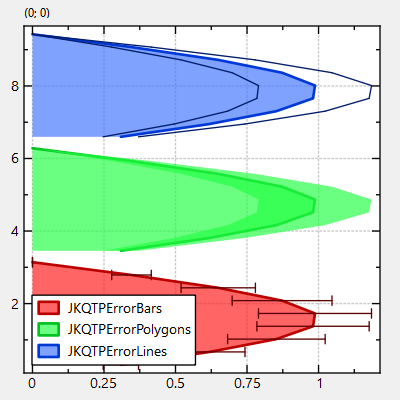mirror of
https://github.com/jkriege2/JKQtPlotter.git
synced 2024-11-16 02:25:50 +08:00
74 lines
3.6 KiB
Markdown
74 lines
3.6 KiB
Markdown
# Example (JKQTPlotter): Filled Graphs with Error Indicators {#JKQTPlotterFilledGraphsErrorBars}
|
|
This project (see [`filledgraphs_errors`](https://github.com/jkriege2/JKQtPlotter/tree/master/examples/filledgraphs_errors) shows how to draw filled graphs with different styles of error indicators.
|
|
|
|
The source code of the main application is (see [`filledgraphs_errors.cpp`](https://github.com/jkriege2/JKQtPlotter/tree/master/examples/filledgraphs_errors/filledgraphs_errors.cpp):
|
|
```.cpp
|
|
// 1. create a plotter window and get a pointer to the internal datastore (for convenience)
|
|
JKQTPlotter plot;
|
|
JKQTPDatastore* ds=plot.getDatastore();
|
|
|
|
// 2. now we create three columns for key and value
|
|
size_t columnK=ds->addLinearColumn(9, 0.1*JKQTPSTATISTICS_PI, 1.0*JKQTPSTATISTICS_PI,"k");
|
|
size_t columnK2=ds->addLinearColumn(9, 1.1*JKQTPSTATISTICS_PI, 2.0*JKQTPSTATISTICS_PI,"k2");
|
|
size_t columnK3=ds->addLinearColumn(9, 2.1*JKQTPSTATISTICS_PI, 3.0*JKQTPSTATISTICS_PI,"k2");
|
|
size_t columnV=ds->addColumnCalculatedFromColumn(columnK, [](double x) { return sin(x); }, "v");
|
|
size_t columnV2=ds->addColumnCalculatedFromColumn(columnK2, [](double x) { return -sin(x); }, "v2");
|
|
size_t columnV3=ds->addColumnCalculatedFromColumn(columnK3, [](double x) { return sin(x); }, "v3");
|
|
size_t columnE=ds->addColumnCalculatedFromColumn(columnV, [](double x) { return 0.2*x; }, "error");
|
|
size_t columnE2=ds->addColumnCalculatedFromColumn(columnV2, [](double x) { return 0.2*x; }, "error");
|
|
size_t columnE3=ds->addColumnCalculatedFromColumn(columnV3, [](double x) { return 0.2*x; }, "error");
|
|
|
|
// 3. create a graph in the plot, which plots the dataset with symmetric:
|
|
JKQTPFilledCurveXErrorGraph* graph1=new JKQTPFilledCurveXErrorGraph(&plot);
|
|
graph1->setKeyColumn(columnK);
|
|
graph1->setValueColumn(columnV);
|
|
graph1->setValueErrorColumn(columnE);
|
|
// set error indicator style
|
|
graph1->setValueErrorStyle(JKQTPErrorBars);
|
|
graph1->setTitle(QObject::tr("JKQTPErrorBars"));
|
|
plot.addGraph(graph1);
|
|
|
|
// 4. create a second graph in the plot, which plots the second dataset with outer error bars only:
|
|
JKQTPFilledCurveXErrorGraph* graph2=new JKQTPFilledCurveXErrorGraph(&plot);
|
|
graph2->setKeyColumn(columnK2);
|
|
graph2->setValueColumn(columnV2);
|
|
graph2->setValueErrorColumn(columnE2);
|
|
// set error indicator style
|
|
graph2->setValueErrorStyle(JKQTPErrorPolygons);
|
|
graph2->setTitle(QObject::tr("JKQTPErrorPolygons"));
|
|
plot.addGraph(graph2);
|
|
|
|
// 5. create a third graph in the plot, which plots the second dataset with outer error bars only:
|
|
JKQTPFilledCurveXErrorGraph* graph3=new JKQTPFilledCurveXErrorGraph(&plot);
|
|
graph3->setKeyColumn(columnK3);
|
|
graph3->setValueColumn(columnV3);
|
|
graph3->setValueErrorColumn(columnE3);
|
|
// set error indicator style
|
|
graph3->setValueErrorStyle(JKQTPErrorLines);
|
|
graph3->setTitle(QObject::tr("JKQTPErrorLines"));
|
|
plot.addGraph(graph3);
|
|
|
|
|
|
// 6 autoscale the plot so the graph is contained
|
|
plot.zoomToFit();
|
|
|
|
// 7. show plotter and make it a decent size
|
|
plot.getPlotter()->setKeyPosition(JKQTPKeyInsideBottomLeft);
|
|
plot.setWindowTitle(title);
|
|
plot.show();
|
|
plot.resize(400,400);
|
|
```
|
|
|
|
|
|
The result looks like this:
|
|
|
|

|
|
|
|
|
|
|
|
In order to draw horizontal error bars, you have to use `JKQTPFilledCurveYErrorGraph` instead of `JKQTPFilledCurveXErrorGraph`:
|
|
|
|

|
|
|
|
|